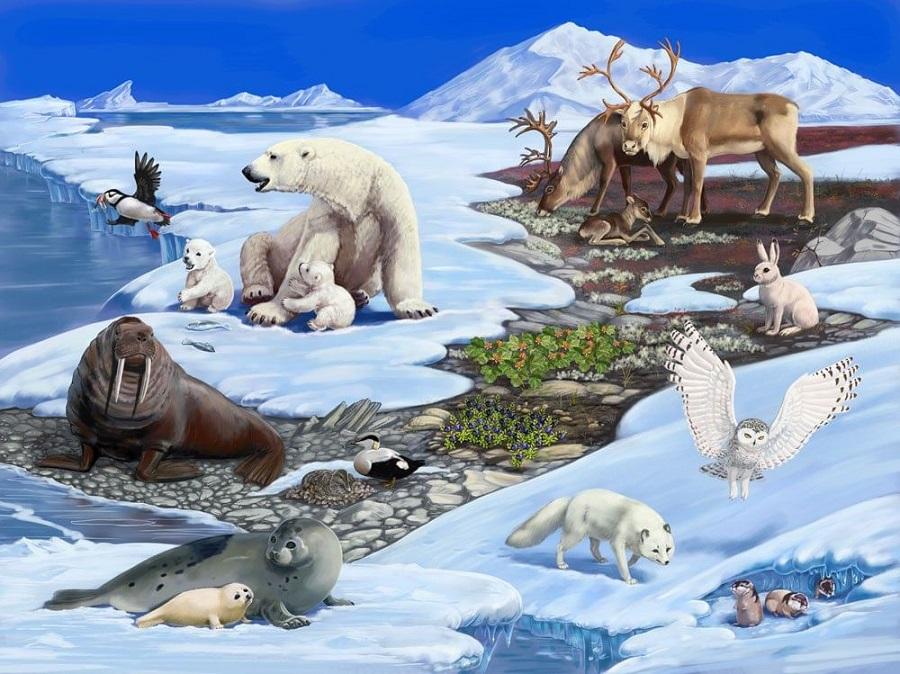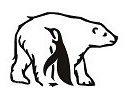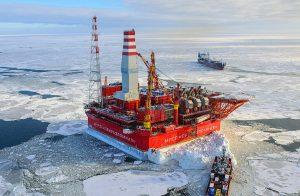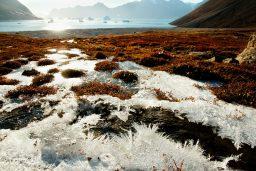
The animal world
Despite the harsh climate, there are not so few animals living in the Arctic. Some of them belong to species that are not found anywhere else on the planet: polar bears, musk oxen and reindeer. Polar bears live right on the ice cover of the seas. They are excellent swimmers, whose thick fur does not allow water or cold to reach their bodies.
The musk ox is the size of an ox, and its coat is thick and long, similar to that of extinct mammoths. On the huge head there are unusually shaped horns that grow down and sideways. Despite its large size, a formidable-looking musk ox can become prey to a wolf, a polar bear, or even a wolverine. Therefore, in case of danger, the musk ox simply runs away.
The reindeer – without it, humans would hardly have been able to explore the northern lands. Reindeer have a number of special features: they lift their legs high when running.,
and this allows them to easily move through wetlands with bumps, through snow and through low bushes. The hooves and toes of deer are designed in such a way that they move apart slightly when in contact with any support, forming a large surface. This helps them not to fall through the snow.
Wolves, Arctic foxes, hares and lemmings can be found in the Arctic. During the summer months, the Arctic shores are filled with a million migratory birds, which take a break here during the long flight home from their wintering grounds. Polar owls, petrels, polar and pink gulls, geese, and sturgeons spend time here all year round.
The ringed seal is one of the smallest seals in the Arctic. It got its name for the light circles on the dark skin. These animals are widespread throughout the Arctic coast. They live apart, only sometimes forming small groups.
Baby squirrels are born in a white fur coat, which begins to darken after two to three months. Squirrels spend all this time of their early childhood in ice caves that protect them from predators and the cold, and feed on their mother’s thick milk.
The walrus is a charismatic representative of pinnipeds. Its distinctive features are whiskers and canines, which can reach one meter in length and
weigh up to five kilograms. Walruses use these tusks for self-defense and foraging, and they use them to get out of the water onto ice floes.
Walruses live in large groups, forming deposits: thousands of individuals gather together to keep warm, raise and protect their cubs together. There are about 200 kilograms of fat in the body of a walrus — it not only protects from the cold, but also increases the buoyancy of animals.
Bowhead whale – in the Russian Arctic there are: Bering-Chukchi and Svalbard species. Migrations of these whales directly depend on the movement,
melting and freezing of ice. Therefore, the intense melting of the ice poses a serious threat to these animals. Bowhead whales are among the centenarians
Earth, their age can reach 200 years.
Belugas are distinguished from other whales by their rounded foreheads, lack of dorsal fins, and cervical vertebrae: they are the only whales that can
move their heads. In addition, they are completely white — this disguise helps them hide from their main enemies: killer whales and polar bears.
Source: Arctic. The Earth’s ice cap. Kapustina O. Yu., Ispenkova N. Yu. – Snezhnogorsk, 2022 – 16 p.


